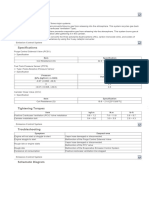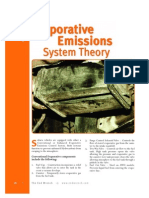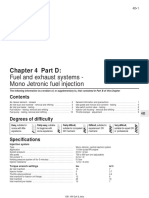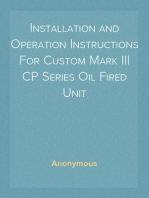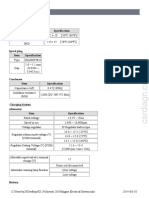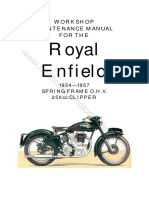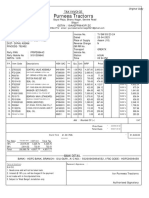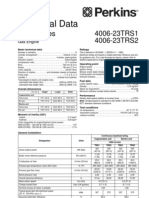Item Specification: Emission Control System
Uploaded by
ZM OhnItem Specification: Emission Control System
Uploaded by
ZM OhnEmission Control System
Description
Emissions Control System consists of three major systems.
• Crankcase Emission Control System prevents blow-by gas from releasing into the atmosphere. This system
recycles gas back into the intake manifold (Closed Crankcase Ventilation Type).
• Evaporative Emission Control System prevents evaporative gas from releasing into the atmosphere. This system
burns gas at appropriate engine operating condition after gathering it in the canister.
• Exhaust Emission Control System converts the three pollutants [hydrocarbons (HC), carbon monoxide (CO),
and oxides of nitrogen (NOx)] into harmless substances by using the 3-way catalytic converter.
Emission Control System
Specifications
Purge Control Solenoid Valve (PCSV)
Specification
Item Specification
Coil Resistance (Ω) 22.0 ~ 26.0 [20°C(68°F)]
Fuel Tank Pressure Sensor (FTPS)
Type: Piezo-Resistive Pressure Sensor
cardiagn.com
Specification
Pressure (kPa) Output Voltage (V)
-3.75 (-0.038, -
4.5
15.05)
0 1.5
+1.25 (0.013, 5.02) 0.5
Canister Close Valve (CCV)
Specification
Item Specification
19.8 ~ 21.8
Coil Resistance (Ω)
[20°C(68°F)]
Tightening Torques
Item kgf.m N.m lb-ft
Positive Crankcase Ventilation (PCV) Valve installation 0.8 ~ 1.2 7.8 ~ 11.8 5.8 ~ 8.7
Emission Control System
Troubleshooting
Symptom Suspect area
Engine will not start or stuggle to start Vapor hose damaged or disconnected
Engine stuggle to start Malfunction of the Purge Control Solenoid Valve
Vapor hose damaged or disconnected
Rough idle or engine stalls
Malfunction of the PCV valve
Rough idle Malfunction of the Evaporative Emission Control System
Excessive oil consumption Positive crankcase ventilation line clogged
Emission Control System
C:\Users\ej20\Desktop\KI 15\Sorento 2015\Emission Control System.mht 2014-06-10
Schematic Diagram
cardiagn.com
Emission Control System
Components Location
C:\Users\ej20\Desktop\KI 15\Sorento 2015\Emission Control System.mht 2014-06-10
cardiagn.com
C:\Users\ej20\Desktop\KI 15\Sorento 2015\Emission Control System.mht 2014-06-10
1. PCV Valve 6. Fuel Level Sender (FLS)
2. Canister 7. Fuel Tank Air Filter
3. Purge Control Solenoid Valve 8. Catalytic Converter [WCC, Bank 1]
(PCSV) 9. Catalytic Converter [WCC, Bank 2]
4. Fuel Tank Pressure Sensor (FTPS) 10. Catalytic Converter [UCC]
5. Canister Close Valve (CCV)
1. PCV Valve 2. Canister
4. Fuel Tank Pressure Sensor (FTPS)
3. Purge Control Solenoid Valve (PCSV)
6. Fuel Level Seder (FLS)
cardiagn.com
5. Canister Close Valve (CCV) 8. Catalytic Converter [WCC, Bank 1]
7. Fuel Tank Air Filter
9. Catalytic Converter [WCC, Bank 2] 10. Catalytic Converter [UCC]
C:\Users\ej20\Desktop\KI 15\Sorento 2015\Emission Control System.mht 2014-06-10
Emission Control System
Schematic Diagram
cardiagn.com
C:\Users\ej20\Desktop\KI 15\Sorento 2015\Emission Control System.mht 2014-06-10
Emission Control System
Inspection
1. After disconnecting the vapor hose from the PCV valve, remove the PCV valve.
2. Reconnect the PCV valve to the vapor hose.
3. Inspect the PCV vlave operation.
(1) Run the engine at idle.
(2) Put a finger on the open end of the PCV valve.
(3) Make sure that intake manifold vaccum can be felt.
The plunger inside the PCV valve will move back and forth at
vacuum.
cardiagn.com
4. If the vacuum is not felt, clean or replace the vapor hose.
Emission Control System
Operation Principle
C:\Users\ej20\Desktop\KI 15\Sorento 2015\Emission Control System.mht 2014-06-10
Emission Control System
Removal
1. Disconnect the vapor hose (A).
2. Remove the PCV valve (B).
Inspection
1. Insert a thin stick (A) into the PCV valve (B) from the threaded side to check that the plunger moves.
cardiagn.com
If the plunger does not move (PCV valve is clogged), clean or replace the valve.
Installation
1. Installation is reverse of removal.
PCV Valve installation :
7.8 ~ 11.8 N.m (0.8 ~ 1.2 kgf.m, 5.8 ~ 8.7 lb-ft)
Emission Control System
Description
Evaporative Emission Control System prevents fuel vapor stored in fuel tank from vaporizing into the atmosphere.
When the fuel evaporates in the fuel tank, the vapor passes through vent hoses or tubes to canister filled with
charcoal. The canister temporarily holds the vapor in the charcoal. If ECM determines to draw the gathered vapor
into the combustion chambers during certain operating conditions, it will vacuum into intake manifold.
Evaporative System Monitoring
C:\Users\ej20\Desktop\KI 15\Sorento 2015\Emission Control System.mht 2014-06-10
cardiagn.com
Evaporative And ORVR Emission Control System
This system consists of below items;
- Fill vent valve
- Fuel shut-off valve
- Fuel cut valve (for roll over)
- Two way valve (pressure/vacuum relief)
- Fuel liquid/vapor separator which is installed beside the filler pipe
- Charcoal canister which is mounted under the rear floor LH side member and protector
- Tubes and miscellaneous connections
While refueling, ambient air is drawn into the filler pipe so as not to emit fuel vapors in the air. The fuel vapor in the
tank is then forced to flow into the canister via the fill vent valve. The fuel liquid/vapor separator isolates liquid fuel
and passes the pure vapor to the charcoal canister.
While the engine is operating, the trapped vapor in the canister is drawn into the intake manifold and then into the
engine combustion chamber. According to this purge process, the charcoal canister is purged and recovers its
absorbing capability.
C:\Users\ej20\Desktop\KI 15\Sorento 2015\Emission Control System.mht 2014-06-10
1. Fuel Filler Cap 8. Evaporative Hose
cardiagn.com
2. Fuel Filler Pipe 9. Canister
3. Fuel Shut-OFF Valve 10. Canister Close Valve (CCV)
4. Fuel Tank 11. Fuel Feed Line
5. ORVR Valve 12. Fuel Tank Pressure Sensor
6. 2-Way & Cut Valve (FTPS)
7. Evaporative Hose 13. Purge Control Solenoid
Valve (PCSV)
Emission Control System
Schematic Diagram
C:\Users\ej20\Desktop\KI 15\Sorento 2015\Emission Control System.mht 2014-06-10
cardiagn.com
Canister
Canister is filled with charcoal and absorbs evaporated vapor in fuel tank. The gathered fuel vapor in canister is
drawn into the intake manifold by the ECM/PCM when appropriate conditions are set.
Purge Control Solenoid Valve (PCSV)
Purge Control Solenoid Valve (PCSV) is installed in the passage connecting canister and intake manifold. It is a duty
type solenoid valve and is operated by ECM/PCM signal.
To draw the absorbed vapor into the intake manifold, the ECM/PCM will open the PCSV, otherwise the passage
remains closed.
Fuel Filler Cap
A ratchet tightening device on the threaded fuel filler cap reduces the chances of incorrect installation, seals the fuel
filler. After the gasket on the fuel filler cap and the fill neck flange make contact, the ratchet produces a loud clicking
noise indicating the seal has been set.
Fuel Tank Pressure Sensor (FTPS)
The Fuel Tank Pressure Sensor (FTPS) is an integral part of the monitoring system. The FTPS checks Purge Control
Solenoid Valve (PCSV) operation and leaks in the Evaporative Emission Control System by monitoring pressure and
vacuum level in the fuel tank during PCSV operating cycles.
Canister Close Valve (CCV)
The Canister Close Valve (CCV) is located between the canister and the fuel tank air filter. It closes off the air inlet
to the canister for the Evaporative Emissions System and also prevents fuel vapors from escaping from the Canister
when the vehicle is not operating.
Evaporative System Monitoring
Evaporative Emission Control Monitoring System consists of fuel vapor generation, evacuation, and leakage check
step. At first, the OBD-II system checks if vapor generation due to fuel temperature is small enough to start
monitoring. Then it evacuates the evaporative system by means of PCSV with ramp in order to maintain a certain
vacuum level. The final step is to check if there is vacuum loss by any leakage of the system.
Vapor Generation Checking
During stabilization period, the PCSV and the CCV are closed. The system pressure is measured as starting pressure
(DP_A). After a certain defined period (T1), the system pressure (DP_B) is measured again and the difference from
the starting pressure is calculated. If this difference (DP_B - DP_A) is bigger than a threshold, there should be
excessive vapor and the monitor is aborted for next checking. On the contrary, if the difference is lower than another
negative threshold, PCSV is regarded as malfunction such as clogged at open position.
C:\Users\ej20\Desktop\KI 15\Sorento 2015\Emission Control System.mht 2014-06-10
Evacuation
PCSV is opened with a certain ramp for the pressure to reach down to a certain level. If pressure can’t be lowered
below a threshold, the system is regarded as fuel cap-opened or having a large leakage.
Leaking Checking
PCSV is closed and the system waits for a period to get stabilized pressure. During checking period (T2), the system
measures the beginning and the end of the system pressure (DP_C, DP_D). The diagnosis value is the pressure
difference corrected by natural vapor generation (DP_B - DP_A) rate from the vapor generation checking step.
Components Location
cardiagn.com
1. Purge Control Solenoid Valve 4. Canister Close Valve (CCV)
(PCSV) 5. Canister
2. Vapor line 6. Fuel Tank Pressure Sensor (FTPS)
3. Fuel tank air filter
Emission Control System
Removal
1. Turn the ignition switch OFF and disconnect the battery negative (-) cable.
2. Lift the vehicle.
3. Disconnect the canister close valve connector (A).
C:\Users\ej20\Desktop\KI 15\Sorento 2015\Emission Control System.mht 2014-06-10
4. Disconnect the ventilation tube quick-connector (B) from the fuel tank air filter and canister close valve.
5. Disconnect the vapor tube quick-connector (A).
6. Remove the canister assembly bracket (D) after removing the mounting bolts (B) and nut (C).
cardiagn.com
7. Remove the canister braket (B) installation bolt (A).
8. Remove the fuel tank air filter & canister close valve assembly (A) after rotating it in the direction of the arrow in
the figure.
Inspection
C:\Users\ej20\Desktop\KI 15\Sorento 2015\Emission Control System.mht 2014-06-10
1. Check for the following items visually.
A. Cracks or leakage of the canister
B. Loose connection, distortion, or damage of the vapor hose/tube
A: Canister ↔ Atmosphere
B: Canister ↔ Fuel Tank
C: Canister ↔ Intake Manifold
Installation
1. Install in the reverse order of removal.
Emission Control System
cardiagn.com
Description
A ratchet tightening device on the threaded fuel filler cap reduces the chances of incorrect installation, which would
seal the fuel filler. After the gasket on the fuel filler cap and the filler neck flange contact each other, the ratchet
produces a loud clicking noise indicating the seal has been set.
1. Cover 5. Spring
2. Torsion spring 6. Plate seal
3. Retainer 7. Vacuum valve
4. Gasket seal 8. Spring
C:\Users\ej20\Desktop\KI 15\Sorento 2015\Emission Control System.mht 2014-06-10
Emission Control System
Removal
1. Turn the ignition switch OFF and disconnect the battery negative (-) cable.
2. Lift the vehicle.
3. Disconnect the canister close valve connector (A).
4. Disconnect the ventilation tube quick-connector (B) from the fuel tank air filter and canister close valve.
5. Disconnect the vapor tube quick-connector (A).
cardiagn.com
6. Remove the canister assembly bracket (D) after removing the mounting bolts (B) and nut (C).
7. Remove the canister braket (B) installation bolt (A).
C:\Users\ej20\Desktop\KI 15\Sorento 2015\Emission Control System.mht 2014-06-10
8. Remove the fuel tank air filter & canister close valve assembly (A) after rotating it in the direction of the arrow in
the figure.
9. Release the lever (A), and then separate the canister close valve (B) from the fuel tank air filter (C) after rotating
it in the direction of the arrow in the figure.
Installation
• Install the component with the specified torques.
cardiagn.com
• Note that internal damage may occur when the component is dropped. In this case, use it after inspecting.
1. Install in the reverse order of removal.
Emission Control System
Description
Exhaust emissions (CO, HC, NOx) are controlled by a combination of engine modifications and the addition of
special control components.
Modifications to the combustion chamber, intake manifold, camshaft and ignition system form the basic control
system.
These items have been integrated into a highly effective system which controls exhaust emissions while maintaining
good drivability and fuel economy.
Air/Fuel Mixture Control System [Multiport Fuel Injection (MFI) System]
The MFI system uses signals from the heated oxygen sensor to activate and control the injector installed in the
manifold for each cylinder, thus precisely regulating the air/fuel mixture ratio and reducing emissions.
This in turn allows the engine to produce exhaust gas of the proper composition to permit the use of a three way
catalyst. The three way catalyst is designed to convert the three pollutants [hydrocarbons (HC), carbon monoxide
(CO), and oxides of nitrogen (NOx)] into harmless substances. There are two operating modes in the MFI system.
C:\Users\ej20\Desktop\KI 15\Sorento 2015\Emission Control System.mht 2014-06-10
1. Open Loop air/fuel ratio is controlled by information programmed into the ECM.
2. Closed Loop air/fuel ratio is adjusted by the ECM based on information supplied by the oxygen sensor.
Emission Control System
Description
The catalytic converter of the gasoline engine is a three way catalyst. It oxidizes carbon monoxide and hydrocarbons
(HC), and separates oxygen from the oxides of nitrogen (NOx).
cardiagn.com
Emission Control System
Removal
[Catalytic Converter (WCC)]
1. Remove the exhaust manifold.
(Refer to Engine Mechanical System - "Exhaust Manifold")
[Catalytic Converter (UCC)]
1. Remove the Center Muffler.
(Refer to Engine Mechanical System - "Center Muffler")
Installation
1. Install in the reverse order of removal.
Emission Control System
C:\Users\ej20\Desktop\KI 15\Sorento 2015\Emission Control System.mht 2014-06-10
Description
Continuous Variable Valve Timing (CVVT) system advances or retards the valve timing of the intake and exhaust
valve in accordance with the ECM control signal which is calculated by the engine speed and load.
By controlling CVVT, the valve over-lap or under-lap occurs, which makes better fuel economy and reduces exhaust
gases (NOx, HC). CVVT improves engine performance through reduction of pump loss, internal EGR effect,
improvement of combustion stability, improvement of volumetric efficiency, and increase of expansion work.
This system consist of
- the CVVT Oil Control Valve (OCV) which supplies the engine oil to the cam phaser or runs out the engine oil
from the cam phaser in accordance with the ECM PWM (Pulse With Modulation) control signal,
- the CVVT Oil Temperature Sensor (OTS) which measures the engine oil temperature,
- and the Cam Phaser which varies the cam phase by using the hydraulic force of the engine oil.
The engine oil getting out of the CVVT oil control valve varies the cam phase in the direction (Intake
Advance/Exhaust Retard) or opposite direction (Intake Retard/Exhaust Advance) of the engine rotation by rotating
the rotor connected with the camshaft inside the cam phaser.
cardiagn.com
Operation Principle
The CVVT has the mechanism rotating the rotor vane with hydraulic force generated by the engine oil supplied to the
advance or retard chamber in accordance with the CVVT oil control valve control.
C:\Users\ej20\Desktop\KI 15\Sorento 2015\Emission Control System.mht 2014-06-10
cardiagn.com
[CVVT System Mode]
C:\Users\ej20\Desktop\KI 15\Sorento 2015\Emission Control System.mht 2014-06-10
(1) Low Speed / Low Load (2) Part Load
(3) Low Speed / High Load (4) High Speed / High Load
cardiagn.com
Exhaust Valve Intake Valve
Driving
Condition Valve Valve
Effect Effect
Timing Timing
(1) Low * Valve Under-lap
Completely Completely * Valve Under-lap
Speed * Improvement of
Advance Retard * Improvement of combustion stability
/Low Load combustion stability
* Increase of expansion
work
(2) Part
Retard * Reduction of pumping Retard * Reduction of pumping loss
Load
loss
* Reduction of HC
(3) Low
* Increase of expansion * Prevention of intake back flow (Improvement
Speed Retard Advance
work of volumetric efficiency)
/High Load
(4) High
* Reduction of pumping
Speed Advance Retard * Improvement of volumetric efficiency
loss
/High Load
C:\Users\ej20\Desktop\KI 15\Sorento 2015\Emission Control System.mht 2014-06-10
You might also like
- 2003 Nissan Altima 2.5 Serivce Manual FLNo ratings yet2003 Nissan Altima 2.5 Serivce Manual FL10 pages
- Manual Taller Kymco Xciting 400s INGLES PDFNo ratings yetManual Taller Kymco Xciting 400s INGLES PDF426 pages
- Item Specification: Emission Control SystemNo ratings yetItem Specification: Emission Control System20 pages
- SM - 04 Tucson TL 2015+ 1.6L - Emission Control SystemNo ratings yetSM - 04 Tucson TL 2015+ 1.6L - Emission Control System19 pages
- 2003-2006 Kia Opirus - Emission Control System PDFNo ratings yet2003-2006 Kia Opirus - Emission Control System PDF30 pages
- Chapter 4 Part D: Emission Control SystemsNo ratings yetChapter 4 Part D: Emission Control Systems3 pages
- AIM:-Service Positive Crankcase Ventilation System: Practical - 3No ratings yetAIM:-Service Positive Crankcase Ventilation System: Practical - 36 pages
- 310-00C Fuel System - General Information - 5.0L 32V Ti-VCT/5.0L Ti-VCT V8 (308kW/418PS) 2016 MustangNo ratings yet310-00C Fuel System - General Information - 5.0L 32V Ti-VCT/5.0L Ti-VCT V8 (308kW/418PS) 2016 Mustang30 pages
- Installation and Operation Instructions For Custom Mark III CP Series Oil Fired UnitFrom EverandInstallation and Operation Instructions For Custom Mark III CP Series Oil Fired UnitNo ratings yet
- Operator's Guide to General Purpose Steam Turbines: An Overview of Operating Principles, Construction, Best Practices, and TroubleshootingFrom EverandOperator's Guide to General Purpose Steam Turbines: An Overview of Operating Principles, Construction, Best Practices, and Troubleshooting5/5 (1)
- Marvel Carbureter and Heat Control As Used on Series 691 Nash Sixes Booklet SFrom EverandMarvel Carbureter and Heat Control As Used on Series 691 Nash Sixes Booklet SNo ratings yet
- Stories from the Road 3: An Automotive Case Studies SeriesFrom EverandStories from the Road 3: An Automotive Case Studies SeriesNo ratings yet
- Replacement Replacement Replacement: Semcon JLR Owner Guide Ver 1.00 LANGUAGE: English-En MARQUE: Landrover ModelNo ratings yetReplacement Replacement Replacement: Semcon JLR Owner Guide Ver 1.00 LANGUAGE: English-En MARQUE: Landrover Model7 pages
- Fitting Instructions - Defender td5 SnorkelNo ratings yetFitting Instructions - Defender td5 Snorkel7 pages
- Land Rover Bosch GS8.87 Transmission Management (D2 & RR P38)No ratings yetLand Rover Bosch GS8.87 Transmission Management (D2 & RR P38)13 pages
- D4 Maintenance Check Sheet - Discovery 4 (LA) All Models - UK EU - 10-11MY - KM100% (1)D4 Maintenance Check Sheet - Discovery 4 (LA) All Models - UK EU - 10-11MY - KM2 pages
- Heating, Ventilation and Air ConditioningNo ratings yetHeating, Ventilation and Air Conditioning88 pages
- Tightening Torques Items N.M KGF.M LB-FT: 4 Wheel Drive (4WD) SystemNo ratings yetTightening Torques Items N.M KGF.M LB-FT: 4 Wheel Drive (4WD) System35 pages
- Nanocom Evolution TD5 Map Facility and GuideNo ratings yetNanocom Evolution TD5 Map Facility and Guide2 pages
- Illustrated Spare Part List FOR: Kirloskar Oil Engines Limited100% (1)Illustrated Spare Part List FOR: Kirloskar Oil Engines Limited97 pages
- Servicing Your HMV Oil Filter - Military Trader - VehiclesNo ratings yetServicing Your HMV Oil Filter - Military Trader - Vehicles7 pages
- Naza Ria Rover KV6 Engine Cam Marking Manual PDF100% (2)Naza Ria Rover KV6 Engine Cam Marking Manual PDF7 pages
- Power Source Turn Signal and Hazard Warning Light (From Aug. 2006 Production)No ratings yetPower Source Turn Signal and Hazard Warning Light (From Aug. 2006 Production)1 page
- Fuel & Injection Pump (Kubota - V2003TMDI - Tier II) - (S - N 525011001 & Above, 525111001 & Above) - S185 PDFNo ratings yetFuel & Injection Pump (Kubota - V2003TMDI - Tier II) - (S - N 525011001 & Above, 525111001 & Above) - S185 PDF2 pages
- Purneea Tractorrs: GSTIN: 19AAZFP9643F1ZCNo ratings yetPurneea Tractorrs: GSTIN: 19AAZFP9643F1ZC2 pages
- Piston: Jump To Navigationjump To SearchNo ratings yetPiston: Jump To Navigationjump To Search37 pages
- SCANIAe wsm020201en-GB06 All Marine EnginesNo ratings yetSCANIAe wsm020201en-GB06 All Marine Engines44 pages
- TCD 2013, 2300 093 KW TCD 2013 L04 2V Q410 Tier3No ratings yetTCD 2013, 2300 093 KW TCD 2013 L04 2V Q410 Tier31 page
- Ipd Parts For Detroit Diesel 60 Series Quick RefNo ratings yetIpd Parts For Detroit Diesel 60 Series Quick Ref2 pages
- SM - 04 Tucson TL 2015+ 1.6L - Emission Control SystemSM - 04 Tucson TL 2015+ 1.6L - Emission Control System
- 2003-2006 Kia Opirus - Emission Control System PDF2003-2006 Kia Opirus - Emission Control System PDF
- AIM:-Service Positive Crankcase Ventilation System: Practical - 3AIM:-Service Positive Crankcase Ventilation System: Practical - 3
- 310-00C Fuel System - General Information - 5.0L 32V Ti-VCT/5.0L Ti-VCT V8 (308kW/418PS) 2016 Mustang310-00C Fuel System - General Information - 5.0L 32V Ti-VCT/5.0L Ti-VCT V8 (308kW/418PS) 2016 Mustang
- Installation and Operation Instructions For Custom Mark III CP Series Oil Fired UnitFrom EverandInstallation and Operation Instructions For Custom Mark III CP Series Oil Fired Unit
- Automotive Variable Valve Timing & Lift ExplainedFrom EverandAutomotive Variable Valve Timing & Lift Explained
- Operator's Guide to General Purpose Steam Turbines: An Overview of Operating Principles, Construction, Best Practices, and TroubleshootingFrom EverandOperator's Guide to General Purpose Steam Turbines: An Overview of Operating Principles, Construction, Best Practices, and Troubleshooting
- Marvel Carbureter and Heat Control As Used on Series 691 Nash Sixes Booklet SFrom EverandMarvel Carbureter and Heat Control As Used on Series 691 Nash Sixes Booklet S
- Stories from the Road 3: An Automotive Case Studies SeriesFrom EverandStories from the Road 3: An Automotive Case Studies Series
- Replacement Replacement Replacement: Semcon JLR Owner Guide Ver 1.00 LANGUAGE: English-En MARQUE: Landrover ModelReplacement Replacement Replacement: Semcon JLR Owner Guide Ver 1.00 LANGUAGE: English-En MARQUE: Landrover Model
- Land Rover Bosch GS8.87 Transmission Management (D2 & RR P38)Land Rover Bosch GS8.87 Transmission Management (D2 & RR P38)
- D4 Maintenance Check Sheet - Discovery 4 (LA) All Models - UK EU - 10-11MY - KMD4 Maintenance Check Sheet - Discovery 4 (LA) All Models - UK EU - 10-11MY - KM
- Tightening Torques Items N.M KGF.M LB-FT: 4 Wheel Drive (4WD) SystemTightening Torques Items N.M KGF.M LB-FT: 4 Wheel Drive (4WD) System
- Illustrated Spare Part List FOR: Kirloskar Oil Engines LimitedIllustrated Spare Part List FOR: Kirloskar Oil Engines Limited
- Servicing Your HMV Oil Filter - Military Trader - VehiclesServicing Your HMV Oil Filter - Military Trader - Vehicles
- Power Source Turn Signal and Hazard Warning Light (From Aug. 2006 Production)Power Source Turn Signal and Hazard Warning Light (From Aug. 2006 Production)
- Fuel & Injection Pump (Kubota - V2003TMDI - Tier II) - (S - N 525011001 & Above, 525111001 & Above) - S185 PDFFuel & Injection Pump (Kubota - V2003TMDI - Tier II) - (S - N 525011001 & Above, 525111001 & Above) - S185 PDF












